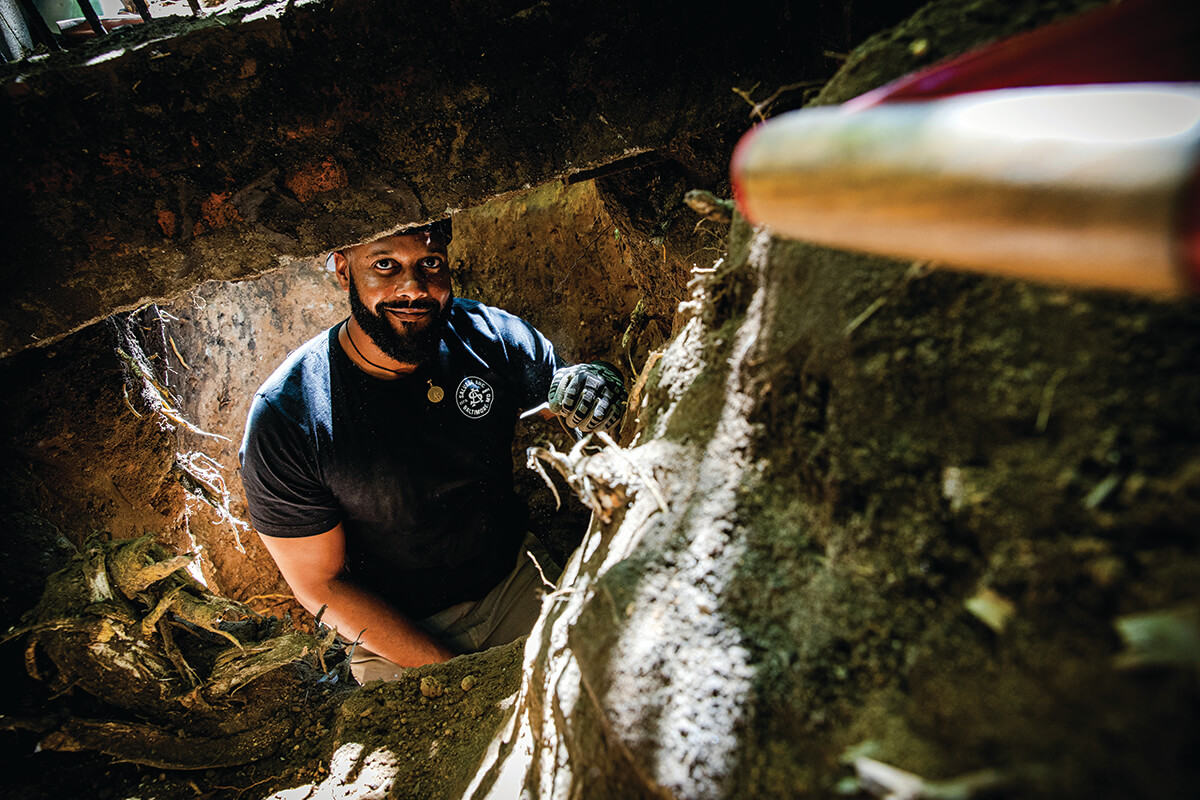History & Politics
Why Archaeologists Have Long Been Interested in Trash
Evan Woodard unearths curios at local sites and tracks down the stories behind them.

Across the street from the historic Orchard Street United Methodist Church, Evan Woodard looks like he’s pulling up buckets of dirt from an abandoned brick well. Except, it’s kind of the opposite of that. Woodard and his crew, aka “Salvage Arc,” are digging out a 19th-century outhouse, or “privy” back in the day. So those buckets? Yeah, it’s not dirt. It’s fine, dry, ashen…you get the idea.
Why would someone climb 15 feet, sometimes 20 and 30 feet, to unearth a 150-year-old outhouse? The curios along the way, of course: discarded clay tobacco pipes, toothbrushes (bone with boar-hair bristles), broken ceramic plates and pots, leftover teeth and bones from various Sunday dinners, and, if the treasure hunt is particularly fruitful, beautifully embossed rum, whiskey, beer, soda, and pharmacy bottles from Baltimore manufacturers.
As a kid growing up in Laurel, Woodard was into Star Wars, anime, photography, computers, The History Channel, gaming, all of it. He’s basically a big rugged guy wrapped around an inner nerd, with a geeky-but-cool day job. He’s the Ravens’ IT security guy, which means he’s in charge of guarding the team’s financial and personnel records—and yes, playbook. “Let’s just say things get a little more intense, in terms of everything being locked down, when we play Pittsburgh and New England.”
A Patterson Park resident now, the 34-year-old has lived in Toyko, Hong Kong, and India, and his curiosity in “going where you’re not supposed to go” dates back to his childhood. (As a kid, Woodard and his buddies used to jump the fence and explore the nearby wildlife refuge). With the onset of COVID-19, he began casting about for a new hobby, which is how he started asking property owners and contractors if he and his friends could take a look in the hole in the backyard before they paved over an old privy. Often, that’s a rowhouse in Fells Point or one of the city’s other original neighborhoods.
“I’d tried golf, it just wasn’t for me,” he says, lifting a gorgeous, 1860s beer bottle from his living room shelf—a recovered antique from a recent latrine exploration. “I do like being outside, and I do like maps, research, history, and the tactile nature of urban, salvage archaeology. I don’t want to spend my free time in front of a computer.”
Archaeologists have long been interested in trash. But a household toilet contains a unique sort of trash, offering an unusual glimpse into how an individual or family lived, as well as insight into the community. This was especially true when the equivalent of DPW street collection was a twice-a-year visit from a privy cleaner. (Bi-annual garbage pick-up sounds bad, but this was long before today’s disposable society.)
It all becomes especially valuable information when cross-referenced with property records and newspaper archives. “People from an upper-class status would only buy pottery made in Europe,” Woodard explains. “They would also eat more meat, boars and hogs, in the middle of the 1800s, and you’d find more animal teeth and jaws. If we find more oyster shells—fish and oysters were cheap and plentiful—then that would be a working-class household. If they were German, English or French immigrants—there was a French Quarter where Seton Hill is today—you’ll find artifacts, French perfume bottles, that reflect that. In a Jewish household, you’re not going to find the bones of pigs.”
Meanwhile, he continues to track down the stories behind his finds, one of which recently led to the uncovering of what appears to be the wrongful execution of a Black man named John Butler. Woodard had discovered a circa-1890s Heinzerling & Co. soda bottle, and his research into the Heinzerling family led to a story about the son of the company’s founder and namesake serving as a witness to the gallows hanging of Butler, at the time the president of the Colored Republican Club in Baltimore. Maintaining his innocence, Butler was convicted of killing his ex-wife with a cobblestone on Dec. 12, 1900, despite an alibi and no direct evidence.
That find was grim. But other than the occasional recovery of a random headstone, that kind of gruesome thing is unusual. In fact, Woodard’s popular Instagram feed, which has nearly 15,000 followers, is mostly populated with well-composed, arty shots of city buildings, colorful pottery and glassware, and antique medicinal and serum bottles.
“Most of the people who follow me are women, and the posts generally get a lot engagement,” Woodard says. “I’m not sure everyone knows how I find this stuff.”